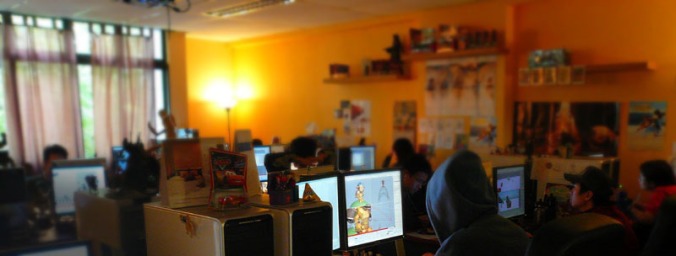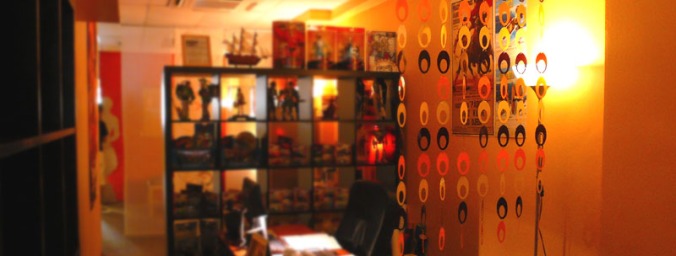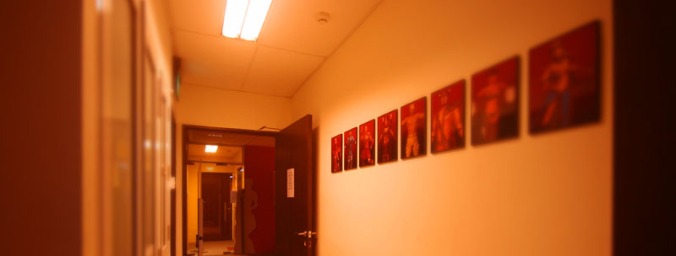
Many people asked me how I bootstrapped my company when I first started. In fact, for the past 10 years since I first started, I’ve been bootstrapping my business, till today. (Read past article with regards to getting the right investors)
(Reference: Bootstrapping in business means starting a business without external help or capital. Such startups fund the development of their company through internal cash flow and are cautious with their expenses. Generally at the start of a venture, a small amount of money will be set aside for the bootstrap process.)
When you first get started, try to keep your overhead as small as possible. We have tried working from home and linking everyone up via FTP. DIY most things on our own. From assembling our own PC / network to basic decor of the office.
In 2007 – this was the first time – I setup my own permanent facility. I was first offered to produce 3 episodes for an animated series project. The project only lasted for 6 months. (Don’t do it like me. Ha ha. Try to ensure you have a project that can last you for at least 12 months. Else it’s too risky.) That is how I started.




(Our first permanent office at Beach Road. We did all the decor and installation, ourselves)
1) FINANCES
When I first started, I had maxed out all my 4 credit cards to buy equipment and furniture. 2 of my cards and the 2 cards of my wife. You need to ensure the first 30% down payment can repay your credit card bills and at least last you for 3 months.
2 Important Things to cover: Labour and Rental. (Try to get an office with at least some basic renovation e.g air conditioning to save cost) If there is something simple you can do on your own to save cost, do it. (I have painted the office myself. This time, the network is more complex. Luckily my lead TD helped me to set it up as I have to doubled up on training and line producing.
For Hardware and Software, pay by installment: Else, it will wipe out your down payment. One of the sources I used was Hitachi Credits. This is known as hired purchase. There are also other sources of installment plans in the market. (Its fortunate that 3d software these days allow you to pay by usage per month) There are a lot more resources these days as compared to when I first started.
You need to ensure you control your cash flow well. Else, you will be in trouble later. If your down payment CANNOT cover your initial cost – (3 months rental, 3 months labour cost, 3 months installment for the Hardware / Software) then you know the project budget probably cannot sustain you and it’s too risky to go ahead.
You also need to make sure the second payment comes in at least one month before you use up the down payment. Therefore, make sure you deliver the milestone on time so that you can collect the second payment.
2) KNOWING THE WHOLE PIPELINE
Before you start working on a series, make sure you are familiar with the whole process and pipeline operations. If it is not you, someone senior in the team must have experience in this.
3) ASSEMBLE YOUR KEY PEOPLE
You need to ensure you have a few key people (or your close friends whom you can trust) who can fit into some of these key roles. (Modeling, Texturing, Rigging, Layout, Animation, Effects, Lighting, Compositing, Editing, IT support.)
Besides the above roles, we were also working on story development and pre production. Hence we also needed to ensure we had expertise in these areas.
4) HUMAN RESOURCE
You cannot suddenly assemble so many people at one go. You probably need to build your network and relations through time. (Read our past article on Maintaining Healthy Relationship with Potential Employees ) So that when the time is right, you know you are ready to assemble the people together. Based on my own experience, you need to have at least 50 artists (from start to finish) to produce 2 episodes a month.
It might sound very straight forward. But one really needs to plan carefully before execution. End of the day, you need to ensure you will not be in debt if the deal does not work out smoothly. Do the above only when you have secured a project.
Hope the above helps you.
Great article David. It is interesting to hear how you did it, and how I’m attempting to setup my company. I think the way I’m doing it is a much slower way, but might be a little less risky. So far I have not put any of my own money into the company. I also don’t have a studio location setup. My plan is to have the money we make from our client projects to eventually pay for a studio space. I also should add I’m not taking a regular paycheck, and most our personal expenses can be covered by my wife. Once the company is making more consistent money I will then start to take a salary. As I mentioned it is a much slower process, and I might take some more risky moves if it feels right. For now I’m just focused on getting more clients to keep us going.
LikeLike
Thanks Eric for your support. Actually you are doing right. Do whatever you are comfortable with. Take it slow.
As for me. I also didn’t put in my own money. In the first place, I do not have any money to put in. ha ha. I am a poor guy. LOL. What I did is to ensure the payments for the projects cover all expenses. That is it. The first project, I did not make money. I breakeven. And earn the hardware and software assets.
One can start with smaller projects. But when opportunity come, one need to be ready. That is what the article is all about. I have been giving consultation to Indonesian companies. Many of them asked me this question. So I am preparing them for it.
Unless you are planning to outsource or if the client allows you to do that. Else one need to have such a setup to engage client or projects of this size. So the focus of the article is how can you engage without getting any money from investors.
Honestly I am learning new things everyday. So that was what I did in the past. But I am sure, there are better ways these days with so many new digital technology.
Like I said, the most important part is planning and controlling your cash flow well. Do not anyhow take loan. Then it should be less risky. In business, somehow there will be risk. But it is important to do calculated risk.
Hope it helps.
LikeLiked by 1 person
Excellent article David! Thank you so much for sharing, that’s very generous of you. And thanks for the inspiration!
LikeLike
Pleasure. Hope it helps you. Sorry for the late reply.
LikeLike
Hope you find this useful too.
https://entrepreneurshipinanimation.wordpress.com/2015/05/18/its-the-journey-that-matters-not-the-destination/
LikeLike